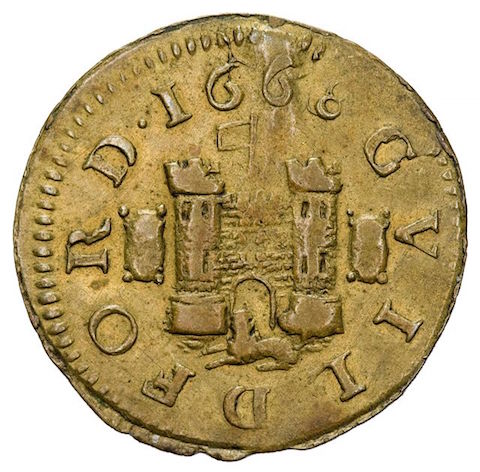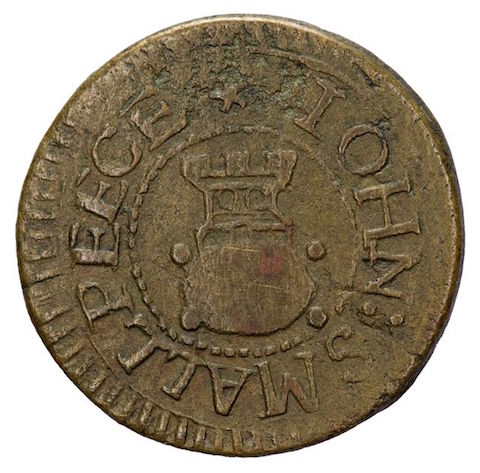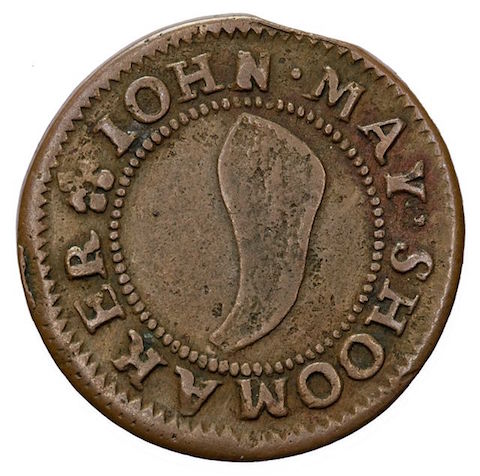 Abraham Lincoln
If given the truth, the people can be depended upon to meet any national crisis...
Abraham Lincoln
If given the truth, the people can be depended upon to meet any national crisis...
 Guildford news...
for Guildford people, brought to you by Guildford reporters - Guildford's own news service
Guildford news...
for Guildford people, brought to you by Guildford reporters - Guildford's own news service
New Book on Surrey Trade Tokens (Brass Farthings) Is A Masterpiece
Published on: 13 Sep, 2015
Updated on: 13 Sep, 2015
Seventeenth Century Trading Tokens of Surrey and Southwark, by Tim Everson.
Review by John Theobald
 A brand-new, completely up-to-date catalogue of Surrey seventeenth century trading tokens has been published.
A brand-new, completely up-to-date catalogue of Surrey seventeenth century trading tokens has been published.
Painstakingly compiled by Tim Everson, Surrey now has its own major catalogue and work of reference on the subject.
The interregnum at the end of the English Civil War and the execution of Charles I up to and including the early part of the reign of Charles II, were extremely turbulent times in rural Surrey, with virtually no low value regal money available in general circulation.
Effectively the country was bankrupt. In desperation, about 20,000 trades people across England and Wales during that brief period of 20 years, mainly men but also women, gradually took it upon themselves to order, issue and use emergency unofficial money, mainly copper or brass farthings, purely in a determined effort to allow everyday village and town life to continue as near to normal as was possible.
Strictly speaking, such tokens were illegal and the issuing of them in theory was strictly forbidden.
However, firstly the Parliamentarians and later the government of Charles II turned a blind eye to their existence, because the situation was so dire.
Part one of the book describes and illustrates each of the 287 different 17th-century trade tokens that were issued and used in the towns and villages of rural Surrey, between about 1650 and 1670.
They appear in alphabetical order of the villages and towns, from Abinger through to Woking. Where more than one token was issued in a place, the tokens are listed in the alphabetical order of the surnames of the issuers.
At the time these tokens were being used, Bermondsey, Newington, Rotherhithe and Southwark also were included within the then Surrey county boundary. The 754 tokens from these London suburbs are listed in part two.
The book will be of especial interest to a number of Guildfordians for a variety of reasons. Importantly, despite the uncertainty of its future, Guildford Museum, at the time of writing this review, currently houses arguably the finest collection in the world of rural Surrey 17th-century trade tokens.
This is comprised of its own museum collection, which has been assembled over the past 100 years. In addition, the collection of Dr Frederick Bailey Penfold (died 1941) is owned by the National Trust and is on permanent loan to the Surrey Archaeological Society.
The collection of the late John Lancaster Wetton (died 1988) was acquired subsequently by the Surrey Archaeological Society. Both of these superb collections are on loan to the museum.
Photographs of many of the tokens in Guildford Museum, especially those in the Penfold and Wetton collections, were taken by Brian Wood for Project Matrix at the Surrey History Centre, Woking and he has allowed them to be used in this new catalogue.
Guildford even issued its own town tokens in 1668, although it was well into Charles II’s reign. They were round brass farthings and probably were intended to provide some urgently needed relief to the poor and needy of the town Parishes.
An old contemporary saying still can be remembered by several older folk: “So poor, he hadn’t even got two brass farthings to rub together.”
Since this was virtually the only time that brass farthings were in general circulation, that saying indicates that their very presence then has left a lasting impression nearly 350 years later.
One of the authors of an earlier catalogue was George C. Williamson who was living in Guildford during the years that his catalogue was being compiled in the 1890s. Despite his work having a number of mistakes and omissions, it continues to be a useful source of reference to token enthusiasts around the world.
The Guildford token issuers’ surnames will be helpful to many local folk. Not a lot is known about most of them, but Mr Everson has included some fascinating details that shed fresh light on Guildford’s residents and tradesmen at that turbulent time.
The majority of Guildford tokens use the symbols of the woolpack, which are taken from the Guildford coat of arms.
This could have been agreed by the traders among themselves, or more probably the town council encouraged their use to unify and promote the town, even before the town issue of its own 1668 brass farthing, which also used the same symbols.
Each token is carefully documented by Mr Everson in the catalogue in a consistent format and has the relevant reference numbers of three earlier major catalogues on the subject.
Produced to a very high standard, which is the hallmark of the book’s publishers, Galata, the catalogue is profusely illustrated with excellent actual-size colour photographs of almost every one of the 1,041 pieces that are listed in the catalogue.
These photographs are essential for such modern catalogues, as they can show minute variations and record the correct readings.
It is important to remember that these tokens were struck, issued and used extensively at a time of great stress and emergency, so only a few of the pieces remain in a pristine condition.
Having said that, the resulting photographic quality of the tokens is excellent. They come in a range of values, shapes and sizes. The rural Surrey tokens mainly were for the value of ¼d (farthing = fourth thing or quarter of one penny), with some being a ½d (halfpenny).
Mainly they were round in shape, but some were square, octagonal and even heart-shaped. Mostly the metals used were brass or copper, but a few were struck in pewter/lead.
The book will appeal to local casual enquirers, family historians, specialist token enthusiasts and Surrey, as well as Guildford researchers, plus students of the local history of this war-torn period in the county.
This listing is a welcome addition to Surrey’s recent social history, is being used already by London auction houses and will provide the definitive guide to these tokens for a long time to come.
The book costs £37 plus £3 for UK postage. It be ordered on the web at www.galata.co.uk

See Dragon story: GBC’s Explanation of Major Land Sale Notice Error ‘Borders on Arrogant’ Says Councillor




Recent Articles
- Surrey Children’s Services Improvement Recognised by Ofsted
- Independent Guildford Stationers Are ‘Top of the Shops’
- Birdwatcher’s Diary No.304
- Cyclist Dies in Peaslake
- Surviving Strategic Director Quits to Take Up CEO Role with a West Sussex Council
- Letter: Damning Reports Should Not Be Used to Gain Political Advantage
- New Leader of the Opposition at Waverley
- Surrey Day’s Celebrations Took to the Skies
- Notice: Dance with Junction 9 to Raise Money for Charities
- Mistreated Former Sub-postmasters Receive Standing Ovation


Search in Site
Media Gallery
Dragon Interview: Local Artist Leaves Her Mark At One of England’s Most Historic Buildings
January 21, 2023 / No Comment / Read MoreDragon Interview: Lib Dem Planning Chair: ‘Current Policy Doesn’t Work for Local People’
January 19, 2023 / No Comment / Read MoreA3 Tunnel in Guildford ‘Necessary’ for New Homes, Says Guildford’s MP
January 10, 2023 / No Comment / Read More‘Madness’ for London Road Scheme to Go Ahead Against ‘Huge Opposition’, Says SCC Leader
January 6, 2023 / No Comment / Read MoreCouncillor’s Son Starts Campaign for More Consultation on North Street Plan
December 30, 2022 / No Comment / Read MoreCounty Council Climbs Down Over London Road Works – Further ‘Engagement’ Period Announced
December 14, 2022 / No Comment / Read MoreDragon Interview: GBC Reaction to the Government’s Expected Decision to Relax Housing Targets
December 7, 2022 / No Comment / Read MoreHow Can Our Town Centre Businesses Recover? Watch the Shop Front Debate
May 18, 2020 / No Comment / Read More









Recent Comments